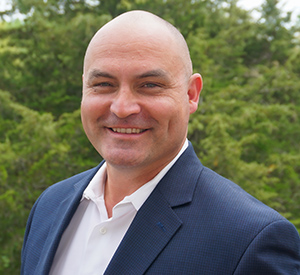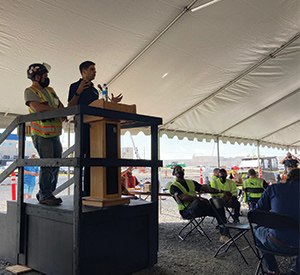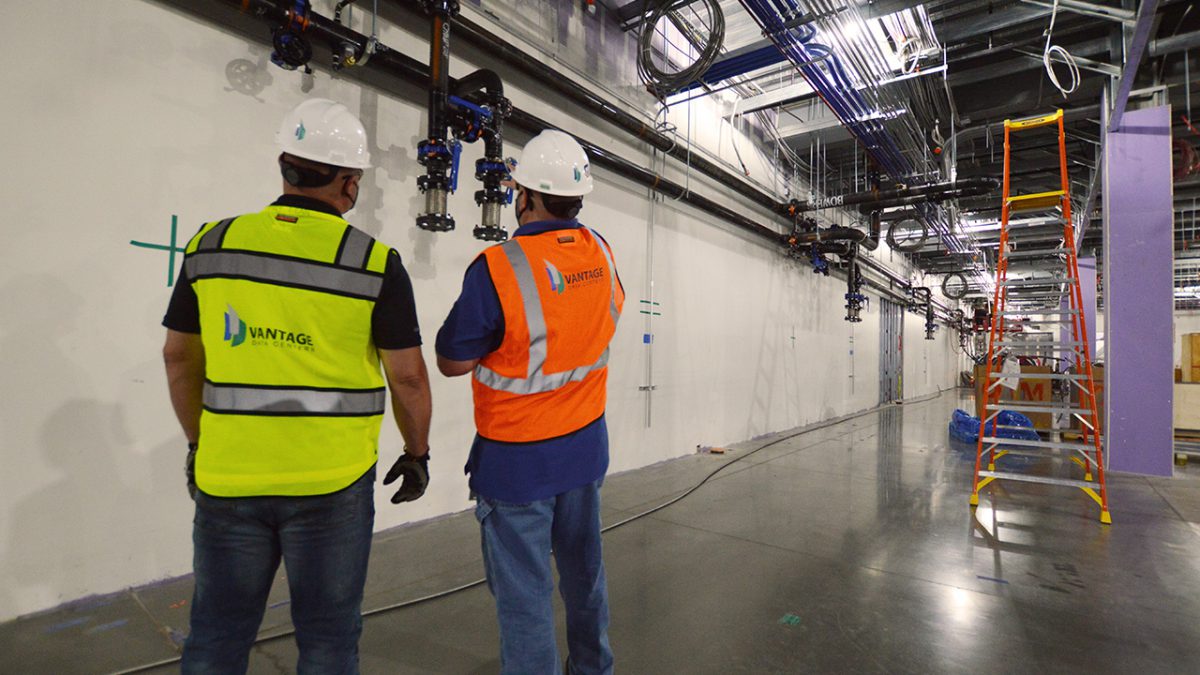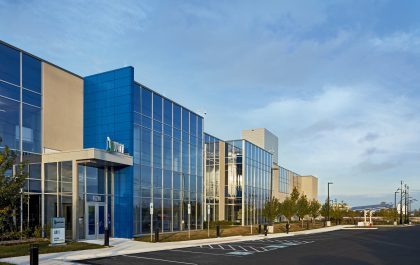As data center construction booms, safety needs to be a top priority.
This week is Construction Safety Week in the United States – which its organizers describe as “an opportunity for people, companies and our entire industry to join together, celebrate and recommit to safety.”
With digital services and applications now essential for every person and organization across the globe, data center development is booming. With so many data centers being erected, Construction Safety Week is an important reminder that – while data center space is necessary for our ever-expanding digital economy – it’s essential that those who are building and operating data centers are doing so safely.
To get a deeper insight into what is necessary to keep construction and operations safe for data center employees, we sat down with Trey Dean, global director of environmental health and safety, at Vantage Data Centers. During our discussion, we asked about the potential hazards that data center employees face, how Vantage is keeping them safe and what hyperscale customers are looking for in their data center provider’s safety program.
Interview with Trey Dean
Data Centers Today (DCT): Tell our readers a little about yourself and your background. How did you get interested in safety? What about the data center sector interested you?

Global Director, Environmental Health & Safety
Trey Dean: I’ve always been interested in risk management and safety. I was a volunteer firefighter for a long time, and that’s where I was exposed to safety in terms of safety officers on emergency sites. That really piqued my curiosity.
While I was in college and taking business classes, I got interested in the business side of safety and how it increases profitability and improves worker productivity and efficiency. I started my safety career teaching simple safety courses on fall protection, CPR and first aid. I then started my own consulting company, and within a few years, I was consulting with dozens of companies in a variety of fields, from construction to data centers and facility management.
As a consultant, I helped my clients build out their entire safety programs from scratch, taking them from nothing to full-fledged safety programs designed to help them protect their assets and their people. I also worked for a few of my clients full-time and gained valuable experience building out safety programs internally. I then got my master’s degree in occupational safety management from Embry-Riddle Aeronautical University and received my certified safety professional designation.
I was first drawn to the data center industry by several of my clients who operated in the data center space as trade contractors. I learned very quickly that it was an exciting industry with a lot of potential for growth and the need to develop mature safety programs.
DCT: What is Vantage doing to enhance the safety of its data centers? How does this compare with industry standards, and what is being done across the industry?
Trey Dean: Our safety management system is ISO-45001 compliant, and that’s a nice baseline. But we take it several steps further.
The backbone of our safety program consists of our policies, assurance, inspection process, promotion, training and overall risk management approach. Our approach and belief are that if we can’t measure it, then we are operating blind. As a result of that, we’ve implemented robust auditing and reporting processes that allow us to receive real-time information on safety activities on our construction sites as well as in our facilities.
That information is then widely shared across the organization. We include weekly updates with our entire executive team, and we share this information with our employees and our customers.
On our construction projects, we incorporate health and safety standards at the RFP stage all the way through commissioning. And we require robust auditing and reporting from our contractor partners. We expect that all those requirements are communicated to every person on the job site. Also, every individual on our project sites has full stop work authority, I don’t care who it is, from the newest and greenest trades person, all the way up the chain.
In our daily operations, safety requirements are embedded in our methods and procedures. Our operations’ critical facility engineers are some of the best in the business. They typically come from backgrounds in higher risk industries and understand safety procedures and requirements. Of course, we constantly measure all these activities and look for opportunities to get better.
Is this unique? I think so. I consider Vantage the standard bearer for safety in the industry. In fact, I just got off my weekly safety call with all our executives, who – much like every week – asked probing questions about safety. They’re involved. That executive-level focus on safety, coupled with our procedures and reporting methodologies, is what sets us apart.
DCT: When people think of data centers, they probably don’t think of a workplace that is particularly hazardous or dangerous. What kinds of safety concerns do data centers face in their daily operations?
Trey Dean: There are actually a host of hazards that are typical for any type of facility management operation inherent in a data center. However, what ultimately differentiates a data center and a typical facility are two primary hazards: electrical hazards and falls.
Obviously, with a data center there is a lot of electricity. As a result, we have extremely detailed safety procedures for interacting with electrical equipment. We are fanatical about controlling hazardous energy, and we avoid working on live electrical equipment unless it’s unavoidable and allowed per regulation.
If employees must work with live electrical equipment, we ensure they have the best personal protection equipment (PPE) they can have, that they wear it and that all procedures are followed. We really do our best to leave nothing to chance. One mistake on a high-voltage panel can be catastrophic. We don’t take that for granted.
DCT: Construction will always be – at its core – inherently dangerous, but what advancements in management, procedures and technologies have helped to make it safer?
Trey Dean: I am in a very fortunate position to work with some of the best construction professionals in the world. Both Vantage employees and the folks that we work with prioritize safety management on our construction sites. It’s a total team effort, and everyone’s got a part to play.
The safety management process starts at contractor vetting. We make sure that contractors and trade partners are qualified to work on our project sites, or they don’t do the work. And we have a strict set of requirements for safety.
Once we do bring a contractor onto a project, we work with the project teams to make sure there’s a process in place to plan for and manage high-risk activities, such as fall protection, electrical, trenching and excavation. We also make sure small things are accounted for, such as ensuring appropriate sanitary facilities, providing break areas, shade areas, bottles of water and a variety of other items to keep people safe.
We try to stay ahead of the issues. We require regular reporting of certain sets of leading indicators from our contractor partners. We require multiple safety inspections each week by Vantage personnel, by contractor personnel, by third-party safety consultants and my department. It’s a redundant approach with many different eyes on hazards. And then we collect this information in our quality and safety software. This enables us to identify trends and track corrective actions, among many other things.
Recently, we began to harness a solution called Power BI to supplement our data analysis. Implementing data analysis on a construction site for safety metrics is fairly cutting edge. We combine that with the human element and communication, and it has proven to be an effective approach.
DCT: How are you measuring success?
Trey Dean: We measure against internally set goals and industry standards. We are in a unique position in that we start out managing construction safety, and then at some point, we transition to facility management safety. And there are two different types of risk approaches. One is construction and the other is more general industry. And there are definitely different standards of success for both of those. We have a standardized set of performance indicators, both for our contractor partners as well as for Vantage employees. We monitor these indicators every day, and in real-time, and adjust our approach if needed.
Ultimately, the key performance indicator or the best measure of success is that every single person who enters our construction site returns home to their family at the end of the day. If we accomplish this, then we are successful.
Depending on the audit underway, at any given time we have up to 1,000 data points that we look at on a construction project. The more information you get, the more reliable it tends to be. We use this information, in many ways, to predict the future. If someone were to ask me right now what the number one hazard is on our project site, I can comfortably and reliably say what that is because of the robust data that we collect.
DCT: When data center customers are looking for a data center provider, is workplace safety something they’re asking about? If so, what criteria are they considering?
Trey Dean: Our customers are hyper focused on workplace safety. It’s a core value for them and a requirement at this point. And, frankly, I don’t believe that we would have customers if we didn’t work safely and have the safety program that we do now have. And we certainly wouldn’t be able to grow.
Customers are focused on the entire lifecycle of safety, just as we are. Do we have the appropriate health and safety policies in place for regulatory requirements and industry best practices? How do we assure safety and report on it? How do we identify trends at Vantage? What training do our employees receive? Do we identify high-risk activities and properly assess and control them? What does our incident history look like?
Ultimately, what they’re trying to identify is our safety culture – which is a hard thing to measure. However, the policies, procedures, reports and auditing that we do, along with training and record keeping, give our customers a good sense of our safety culture and that we’re committed to safety from the top down.

Northern Virginia Construction Safety Week lunch.
DCT: Construction Safety Week 2021 in the United States is this week. Can you tell our readers who may not be familiar with this event what it is and what purpose it serves?
Trey Dean: Construction Safety Week is an annual, week-long event that encourages the construction industry as a whole to recommit to safety so that everybody can return home safely at the end of the day. It’s also an opportunity to say “thank you” to all those who go above and beyond to improve safety on project sites.
At Vantage, we are providing training and safety demos, appreciation lunches and a variety of other activities. Not only that, but safety is also a core value for us. It’s an everyday part of our lives. It’s what we do every week of the year. Construction Safety Week is an opportunity to celebrate that and hopefully save a life through awareness and training.
To learn more about Vantage’s approach to safety, click here.



